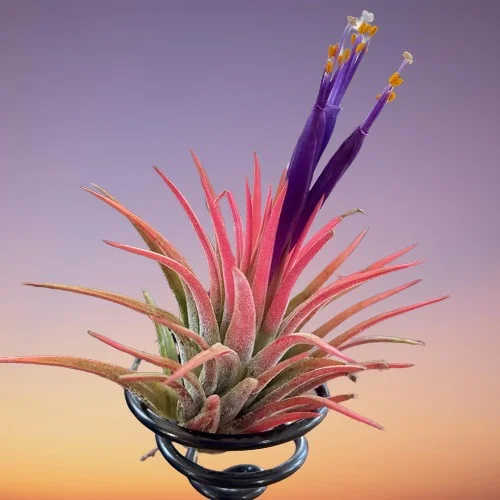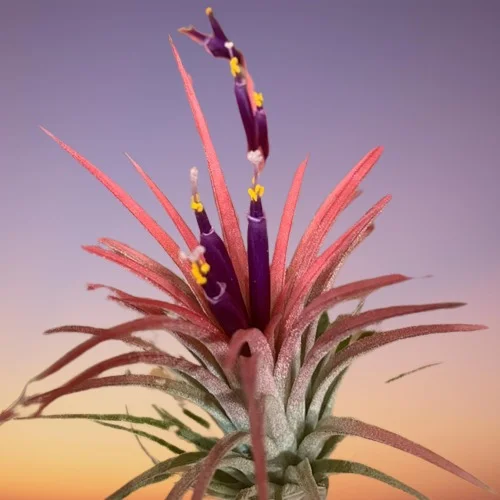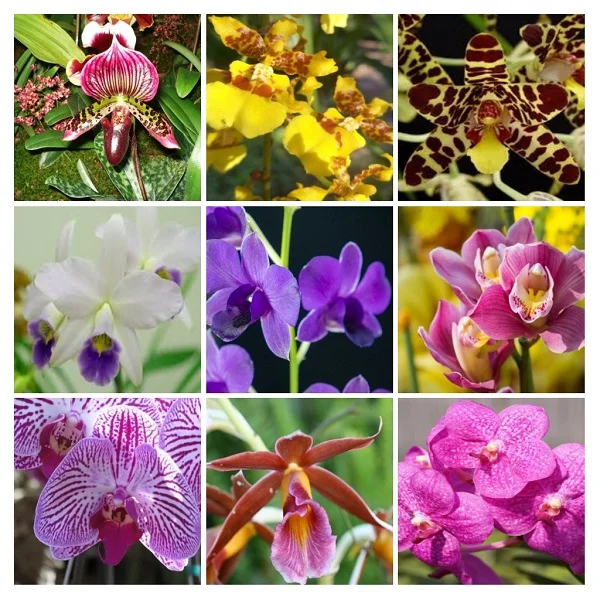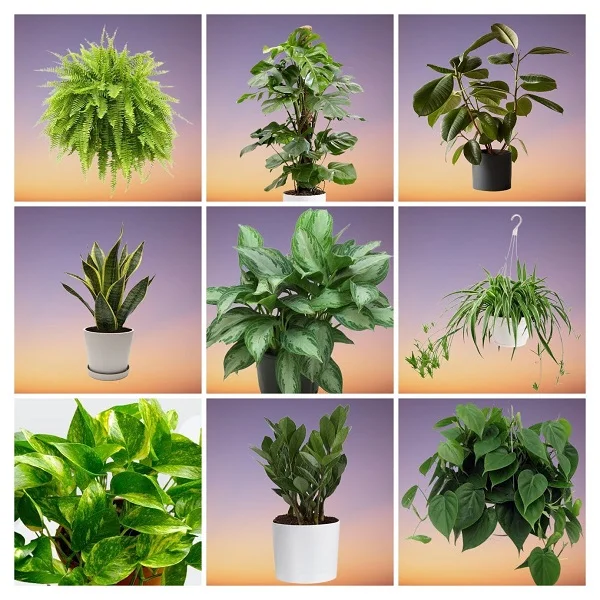How to Grow and Care for Air Plants (Grey Tillandsia) Indoors
Some links in this post may be affiliate links
Air Plants (Grey Tillandsia) require bright light, average warmth, high humidity and fortnightly feeding during the growing season to thrive.
Air Plants are unique Bromeliads varieties that do not need to be planted in a potting medium. They have furry scales on their foliage which take up water from humid air and obtain nutrients from air-borne dust and moisture.
Grey Tillandsia unlike Green Tillandsia literally live on air and hence the common name "Air Plants". They can be displayed by sticking them on coral, shells, drift wood, hanging them and many other ways.
On account of their unique growing characteristics, vibrant foliage when in flower and ease of care, Air Plants are among the most popular indoor plants for the home.

Botanical name: Tillandsia
Family: Bromeliaceae
Sufamily: Tillandsidoeae
Flower
When Air Plants bloom, the leaves around the flowers change color and provide a lasting bright display, but the blooms themselves last only a few days. Once the flower-head fades, the rosette of leaves begins to die and is replaced by offsets (pups) at the base.
Types (Varieties)
The most widespread species of Air Plants is Tillandsia usneoides (Spanish Moss) which can be found hanging on trees throughout the warm tropical forests.
Tillandsia caput-medusae is one of the most popular Air Plants whose thick and twisted leaves arise from a bulbous base and has very showy red bracts and blue flowers.
Another common variety is Tillandsia ionatha which forms a compact rosette of arching silvery leaves and grows only a couple of inches tall. Its inner foliage turns red when the stalkless violet flowers appear.
Tillandsia juncea is a long-leaved species whose rush-like foliage spreads outwards and a single flower-stalk bears the terminal blooms well above the heart of the plant.
Tillandsia argentea is a silvery species whose short leaves spread untidily outwards as the plant develops.
Is Air Plant toxic?
Air Plants (Grey Tillandsia) are non-toxic to humans and pets. The Air Plants are safe to grow indoors.
Related: 15 Indoor Plants that are Safe for Cats and Dogs
Where to Buy
If you are looking to add the beautiful Air Plants to your collection, you may obtain them online from Amazon (Link to Amazon).
Air Plants Care Indoors
Air Plants (Grey Tillandsia) flourish in bright light away from direct sunlight, average warmth of 18-260C, high humidity of 70-80% and fortnightly feeding in the growing season.
Grey Tillandsia require pruning to keep them neat as well as create enough space of the growth of pups. Keep reading for more on these growing conditions and how to provide them.

Light Requirements
Air Plants grow best in bright light. Keep them away from direct sunlight to prevent scorching.
Grey Tillandsia can be grown under grow lights where the natural lighting is not adequate. Take a look at these full spectrum grow lights on Amazon.
Rotate the plant regularly to ensure that the plant receives light on all sides for even growth.
Watering
Watering Air Plants grown in a glass container
Ensure that the container or terrarium has an opening for proper air circulation to prevent rotting and disease infestations.
Water the Air Plant by daily misting of the leaves during the growing season. Reduce misting to 2-3 times weekly during the cold season.
Watering Air Plants that are in the open
Air Plants can be grown mounted like on these cute ceramic hand shape small containers or on these sea urchin shell holders and any other mounting space.
Water these Air Plants by dunking; dip the entire plant into a container of water and allow some time for the plant to absorb the water.
Dunk the plant 2-3 times per week in the growing season and reduce in the cold season.
Shake off excess water and hang it upside-down to ensure no water remains standing in the center as it can lead to rotting.
To ensure that the plant dries out quickly to avoid crown-rot, water it in the morning so that it can dry out during the day when temperatures are higher than at night.
Use tepid, chlorine-free water like rain water to water Grey Tillandsia. Do not use chlorinated water as they are sensitive to chlorine and may cause it die.
Do not use distilled water as the distillation process removes all the nutrients required for growth.
Make sure that there is good air circulation for the Air Plants to prevent pest and disease infestations.
Temperature and Humidity
The best temperature for Air Plants is an average warmth of 18-260C. However, to bring the plant to flower may require temperatures above 260C.
Grey Tillandsia require a humidity of 70-80% that mimicks their natural environment. If the humidity is too low, the plant will respond with brown leaf tips. To elevate humidity, mist it more regularly or use a cool mist humidifier. Ascertain that there is good air circulation to discourage pests and diseases infestation. Learn more on how to increase humidity for houseplants.
Fertilizer
Feed the Air Plant with a liquid fertilizer (foliar feed) every 2 weeks during the growing season to enhance growth.
Do not use a fertilizer that contains urea nitrogen as Grey Tillandsia cannot use urea nitrogen. In addition, do not feed in the cold season as growth is minimal and it may cause fertilizer burn and death of the plant.
Pruning
Pruning Air Plant involves removal of dead leaves to keep the plant neat and to allow adequate room for the new plants to grow. Remove the dead foliage by cutting at the base with a clean knife or a pair of pruning scissors.
Snip off the dry, brown leaf tips with sharp scissors. Cut them at an angle so that they can blend in naturally with the rest of the leaves.
Propagation
Air Plants (Grey Tillandsia) are propagated from offsets (pups) appearing at the base of the plant.
When the offset is several months old or 1/3 to 1/2 the height of mother plant, cut it away from the mother plant.
Confirm that the offset has some roots attached for faster establishment. Display the offset on its own and begin routine care.
Related: How to Propagate Bromeliads from Pups (Bromeliad Propagation from Pups)

Air Plants Problems
Air Plants (Grey Tillandsia) problems include slow growth, plant dying, rotting, brown leaf tips. diseases and pests among others. Keep reading for more on these problems, their remedies and solutions.
Pests
Common pests in Air Plants are scales and mealy bugs. Isolate the affected plant to prevent spread to other plants and treat it for the pests.
To discourage pests infestation, increase humidity by more regular misting or use a cool mist humidifier. You may also grow the plant in a terrarium as high humidity can be maintained inside a terrarium.
Plant dying
Air Plant is dying due to two reasons. If it has not flowered, the cause of death is crown and stem-rot disease due to water sitting in the crown. Always dry any water that settles in the crown after misting or watering.
If the plant has flowered then rotting and death of rosette which bore flower-stalk is natural to give room for the new plants. Remove the dead foliage by cutting at the base with a clean knife or a pair of scissors to allow adequate space for the growth of the pups.
Slow growth and pale leaves
Air Plant slow growth and pale leaves are due to inadequate light. Position the plant in a brighter spot where it will receive bright light or instal a grow light if the natural lighting is not sufficient. Check out this guide on understanding light for houseplants.
Brown leaf tips
Air Plant brown leaf tips are due to three possible causes. One possible cause is underwatering. Water the plant more regularly and ensure the entire plant is thoroughly soaked.
The second possible cause of brown leaf tips in Grey Tillandsia is overfeeding. Reduce either frequency of feeding or quantity of feed as they are slow growers and require very minimal feeding.
The third possible cause of brown leaf tips in Grey Tillandsia is too low humidity. Mist the plant more regularly or grow the plant in a well-lit bathroom, kitchen and other moist areas in the home.
Brown or grey slimy crown and roots
Air Plant brown or grey slimy crown and roots is an indication of rotting due to excess water standing at the base of the crown.
Trim the rotten roots but if the crown is rotten, discard the plant as it is too far gone and can not be saved.
Always drain excess water from the crown after watering or wipe it dry with a soft cloth. Keep the crown dry at all times.
Whitish leaves even after watering
Whitish leaves in Air Plants even after watering is caused by low air humidity as they require a very humid environment to thrive.
Mist the plant more regularly or place it in a glass bowl and keep a wet sponge inside to increase humidity. A cool mist humidifier is also a good option to raise humidity for the plant.
Leaves reddish, dry and brittle
Air Plant leaves reddish, dry and brittle are due to exposure to direct sunlight. Move the plant to a shadier spot or shield it from direct sunlight.
You liked it? Share on social media.
Related Content
Amazon Associates Disclosure
Homeplantsguide.com is a participant in the Amazon Services LLC Associates Program, an affiliate advertising program designed to provide a means for sites to earn advertising fees by advertising and linking to amazon.com.


